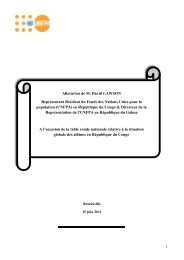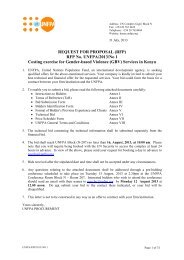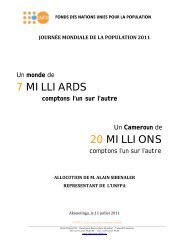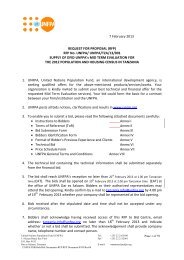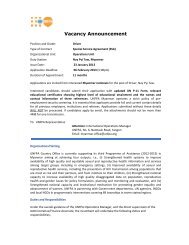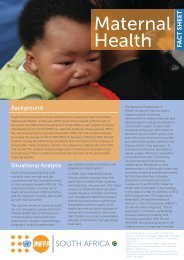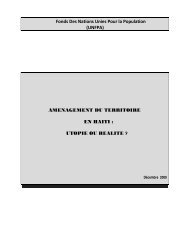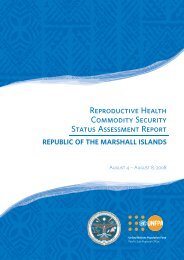GOVERNMENT OF THE REPUBLIC OF ZAMBIA (GRZ) And THE ...
GOVERNMENT OF THE REPUBLIC OF ZAMBIA (GRZ) And THE ...
GOVERNMENT OF THE REPUBLIC OF ZAMBIA (GRZ) And THE ...
You also want an ePaper? Increase the reach of your titles
YUMPU automatically turns print PDFs into web optimized ePapers that Google loves.
Basis of Relationship<br />
1. UNFPA Assistance to Zambia is subject to the provision of Standard Basic Assistance Agreement and<br />
the Exchange of letters signed between the United Nations and the Government of the Republic of<br />
Zambia in September 1996 and ratified by the Government of Zambia in May 2002. The SBAA applies to<br />
UNFPA activities and personnel, mutates mutandis, in accordance with the Letter of the Ministry of<br />
Foreign Affairs of Zambia dated 17th May 2002 Reference Number IOD/101/8/19. Thus, the UN SBAA<br />
and the above Letters constitute the legal basis for the relationship between the Government of Zambia<br />
and UNFPA.<br />
2. The programme described herein has been agreed jointly by the Government of Zambia and UNFPA<br />
and will be covering the period from 1 st January 2011 to 31 st December 2015.<br />
I. Situation Analysis<br />
3. Zambia is rich in mineral resources especially copper, abundant water resources, immense forests and<br />
vast tracts of arable land. This natural bounty provides a strong foundation for economic growth and<br />
development. However, economic and social progress since independence has been highly uneven. Over<br />
the past five years, real Gross Domestic Product (GDP) has grown by an average of 6%; driven by<br />
policies conducive to new foreign investment, strong macro-economic performance, a mining boom and<br />
more than a decade of political stability. Nevertheless, despite these improvements in macroeconomic<br />
indicators and general economic conditions in 2009, it was estimated that about 64 percent of the<br />
population was poor in 2009 and the prospects for achieving most of the Millennium Development Goals<br />
were considered low. Zambia’s Human Development Index in 2010 was 0.395 and was ranked 150 out of<br />
169 countries.<br />
4. According to the 2010 Census, the population of Zambia in 2010 was 13.04 million, with annual<br />
growth estimated at 2.4 percent. The population is projected to reach 15.5 million by 2015. According<br />
to the 2007 Zambia Demographic and Health Survey (ZDHS), the Total Fertility Rate (TFR) is 6.2 at<br />
the national level, reaching 7.5 in rural areas. Though knowledge of family planning is universal, the<br />
contraceptive prevalence rate is 25 per cent for modern methods. The unmet need for family planning<br />
is 27 percent overall but rises up to 47 percent among women aged 40-44 especially in rural areas. The<br />
use of modern contraception is closely associated with education level. Life expectancy at birth is 50<br />
years for males and 55 years for females.<br />
5. Although Zambia’s population has been ageing as fertility and mortality slowly decline, the population<br />
is still relatively young. Forty six per cent of the population is under 15 years of age. The median age<br />
at first marriage for women is 18 years. The teenage pregnancy rate (15-19 years) is at 146 per 1,000<br />
and higher in rural than urban areas. Youth-friendly sexual and reproductive health information and<br />
services are not accessible to a vast majority of young people. Due to the large numbers of adolescents<br />
and young people entering reproductive ages coupled with already low use of family planning services,<br />
the potential for future growth due to population momentum is considerable and may negatively impact<br />
national development indicators. Additionally, the number of young people entering the labour market is<br />
expected to grow steadily over the coming decades—requiring significant investment in comprehensive<br />
youth development so that Zambia benefits from demographic dividend.<br />
6. Commendable progress has been recorded in the reduction of maternal and infant mortality. The<br />
maternal mortality ratio declined from 729 per 100, 000 live births in 2002 to 591 in 2007. The infant<br />
mortality rate declined from 95 deaths per 1,000 live births to 70 over the same period. The decline<br />
could be attributed to increase in births assisted by health workers, increase in community<br />
sensitisation efforts and improved emergency obstetric care.<br />
5




